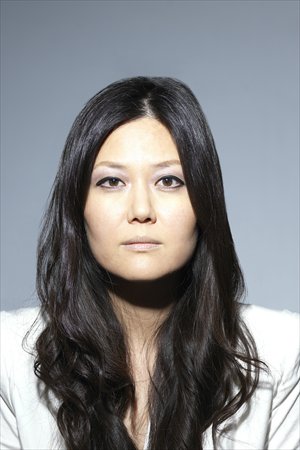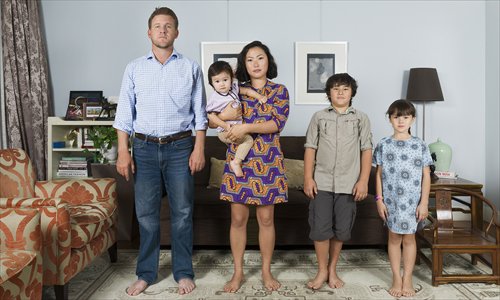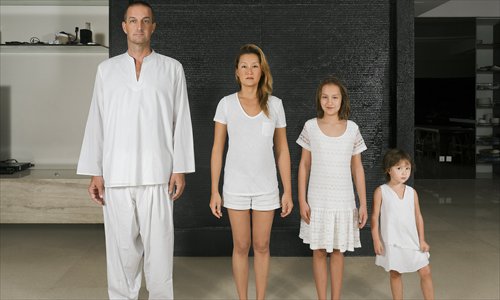'Mixed Blood’

CYJO Photos: Courtesy of CYJO

Snodgrass Family 2013

Huang Rierson Family 2013
To many, the US is no doubt a cultural melting pot as over the years people from various ethnic backgrounds have inhabited the land and collectively created an all new culture. Yet, all the way on the other side of the Earth, a similar situation seems to be emerging in China. Through images seen at the exhibition for Mixed Blood at the Today Art Museum in Beijing, visitors will have the chance to glimpse these changes for themselves.
Cosponsored by the US Embassy in Beijing and the Today Art Museum, the Beijing exhibition for Mixed Blood features photographs and documents created by artist CYJO from 2010 to 2013 documenting 19 families of mixed ethnicities, races and cultures living in Beijing and New York.
In the photographs, family members stand in their own homes in a line with arms at their sides, while next to the photographs are introductions explaining the background of each family member and the story of their family.
Standing in the exhibition hall, these photographs don't just provide a clear image of the life of "mixed families" commonly seen in big cities, but also raise the question: "How far has our society progressed when it comes to ethnicity and race?"
Breaking ground
An American visual artist of South Korean descent, CYJO (Cindy Hwang) has dedicated herself to analyzing how culture, life experience, tradition and modernity shape individuals and our collective identity. Her last project, KYOPO, was a photographic and textual contemporary art project profiling over 200 individuals, mainly Korean-Americans. Discovering during interviews for the project that the backgrounds of these subjects were much more complex than the label Korean-Americans could describe, she came to realize there was much more out there to explore, the idea for Mixed Blood surfaced soon after.
Unlike traditional family shots that show family members smiling and hugging each other, CYJO had all the families involved maintain some space between them as they stood together so no one except mothers holding their children were touching each other. She explained that this allows for easier examination where each individual can be understood.
"It also allows for their own individual identity to be explored more easily within the family unit. Sometimes when we see a family portrait, we see more the collective identity and less of the individual identity," CYJO explained to the Global Times. "I wanted to play with this visual grouping and separation of people in the portrait."
Nik Apostolides, curator and associate director of the Smithsonian National Portrait Gallery in Washington DC, commented on CYJO's work, "I think it's a very contemporary and progressive understanding of family. It gives you a sense of space between each person which also conveys a kind of mental space where each person has their own consciousness, own identity and own purpose."
Although there is no lack of photographers that have taken the life of a family or people of different races as an artistic theme, yet in Apostolides' opinion, Mixed Blood is something different.
He compared the exhibition with Sally Mann's Family Pictures, Teen Tribe which made him feel unsettled and raised questions about privacy and exploitation of families, similar to Nan Goldin's dark and deeply lonely portraits of home and relationships. "They [Sally Mann and Nan Goldin] are showing family as fragile, maybe as fractured, even fragmented," he said.
"It's not that CYJO has necessarily done it better, but that she's showing a very important sense of a home life that is stable and accepting of difference.
"Her work is very much a partnership, it's a collaboration with the family. They are very much welcoming us into their home, so we don't feel that we're intruding on their life," Apostolides said. "They are staring at us in a way that is not confrontational, but maybe questioning or welcoming or inviting."
Stories of interracial families
Through interviews with these 19 families CYJO also unveils the tremendous history behind each family that ties them to their roots.
The unique history of one family in particular, the Huang-Rierson family, left a great impression on her.
Brett Rierson, is an American citizen of Western European descent that moved to the Chinese mainland in 2011, while his wife Rosa Huang is a Belgium citizen of Chinese descent. Her maternal grandfather, a senior general belonging to Chiang Kai-shek's Kuomintang army, was one of the few military officials to survive the Nanjing Massacre, later writing a book where he described how he woke up inside a tomb among a pile of corpses. In 1949, her parents left their respective hometowns in the Chinese mainland for Taiwan, with her father later studying abroad where he became a Belgian citizen. Feeling her life deeply shaped by Chinese history, Huang is deeply interested in exploring modern China and has faith in the people of China and their culture.
"I thought the whole historical aspect, the fact that history still ties her to the mainland and the fact that her family had passed through so many places, only to return here because she wants her children to have a relationship with modern China and its culture is quite moving," said CYJO.
Of course in families made up of people from various cultures, you can expect there to be major differences when it comes to family backgrounds. Take the Mac-Liu family as an example. Pia MacRae is British with Danish, English and Scottish ancestry, while her husband Liu Qing is Chinese with Han and Manchurian ancestry.
"The generational layers in China are so distinct," said MacRae explaining how her mother grew up listening to the Rolling Stones and thinking that Marilyn Monroe was beautiful, things she herself can relate to; while her mother-in-law was born before the liberation, grew up without electricity and even had her feet bound for a period of time. "The cultural gap between generations here is much greater."
Kids with multi-ethnic backgrounds also encounter unique situations as well. MacRae explained that in the UK her two kids are seen as British children with interesting backgrounds, whereas here in China they are seen as foreign children. "If they are a waiguo haizi (foreign kid) here, where are they not a waiguo haizi?" MacRae said during her interview with CYJO for the project.
Danna Liu MacRae, the Mac-Liu family's daughter also described some of the amusing situations she runs into, "It's funny when some people look at me in confusion because they can't figure out where I'm from. It's also funny to experience the different responses from the community when I'm with my parents." She explained that when she's with her mom, people tend to speak to her in English and offer them high prices while when she's with her dad, people speak Chinese to her and they get better prices.
These interviews show that gaps and differences do exist in every mixed raced family, but it's also quite clear that willingness, acceptance, understanding of each family member is also an integral part of the family dynamic.
Mixed Blood runs until June 18, after which it will head to Chengdu, Sichuan Province.